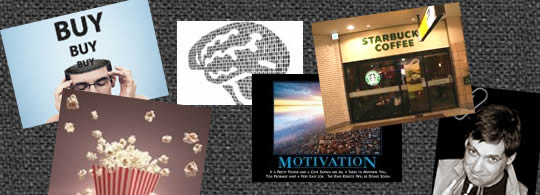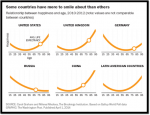Killer Headlines: 3 Must-Read Posts, and More – Roger’s Picks

Here’s the best content we found this week! Want to help thousands of fellow readers? Share your own great find in a comment!
3 Ways To Create Killer Headlines
 Email is still the most reliable and effective way to reach your customers or prospects, but most emails don’t get opened. Even when they do get opened, few links actually get clicked. In 12 Tips to Boost Email Click Through Rates plus 23 Strategic Subject Lines, Jesse Aaron (@JesseAarone) gives you a range of solutions to get opens and clicks. Handy for content marketers, whose brilliant prose won’t matter if the promotion phase doesn’t work.
Email is still the most reliable and effective way to reach your customers or prospects, but most emails don’t get opened. Even when they do get opened, few links actually get clicked. In 12 Tips to Boost Email Click Through Rates plus 23 Strategic Subject Lines, Jesse Aaron (@JesseAarone) gives you a range of solutions to get opens and clicks. Handy for content marketers, whose brilliant prose won’t matter if the promotion phase doesn’t work.
 Now that your head is full of clever titles and headlines inspired by the previous post, here’s some test data to help you refine them… Sarah Goliger‘s (@sarahbethgo) Hubspot post, How to Attract More Clicks to Your Blog Posts: 11 Revealing Title Tests, adds A/B test results to further inform your title selection.
Now that your head is full of clever titles and headlines inspired by the previous post, here’s some test data to help you refine them… Sarah Goliger‘s (@sarahbethgo) Hubspot post, How to Attract More Clicks to Your Blog Posts: 11 Revealing Title Tests, adds A/B test results to further inform your title selection.
 Paid ads aren’t just for driving traffic. Even if you don’t normally use pay-per-click ads because you can’t justify the spend, you may still want to use them for testing purposes. Shannon Skinner (@shanventures) shows how paid ads can be a quick, easy, and surprisingly inexpensive way to test headlines and other content in Use Paid Promotion to Refine Your SEO and Make Your Visitors More Valuable. (Pro tip: authors trying to choose the best title for their upcoming book have been known to use the same approach!)
Paid ads aren’t just for driving traffic. Even if you don’t normally use pay-per-click ads because you can’t justify the spend, you may still want to use them for testing purposes. Shannon Skinner (@shanventures) shows how paid ads can be a quick, easy, and surprisingly inexpensive way to test headlines and other content in Use Paid Promotion to Refine Your SEO and Make Your Visitors More Valuable. (Pro tip: authors trying to choose the best title for their upcoming book have been known to use the same approach!)
Compelling Content, Continued
 Adam Grant (@AdamMGrant), writing at Psychology Today, dwells on a favorite topic of mine: how today’s businesses need to be more brain-oriented and base management practices on research and actual data, not seat-of-the-pants guesswork or out-of-date “best practices.” Discover a few ways to do this in Grant’s Teaching Psychology to Leaders.
Adam Grant (@AdamMGrant), writing at Psychology Today, dwells on a favorite topic of mine: how today’s businesses need to be more brain-oriented and base management practices on research and actual data, not seat-of-the-pants guesswork or out-of-date “best practices.” Discover a few ways to do this in Grant’s Teaching Psychology to Leaders.
 Want Neuromarketing 101 in a long blog post? Jeremy Smith (@jeremysaid) gives you that in Can Neuromarketing Predict what Users will Click on and Buy?. It’s a balanced look at the field (that includes one dubious claim involving neuromarketing genealogy 😉 ), with links to a variety of resources.
Want Neuromarketing 101 in a long blog post? Jeremy Smith (@jeremysaid) gives you that in Can Neuromarketing Predict what Users will Click on and Buy?. It’s a balanced look at the field (that includes one dubious claim involving neuromarketing genealogy 😉 ), with links to a variety of resources.
 My friend Chris Goward (@chrisgoward) has posted a neuromarketing primer with a twist: he ties it into his favorite topic, conversion optimization. In his article How to Get Real Neuromarketing Insights, Cris provides both theory and practical advice to ad some “neuro” magic to your CRO efforts.
My friend Chris Goward (@chrisgoward) has posted a neuromarketing primer with a twist: he ties it into his favorite topic, conversion optimization. In his article How to Get Real Neuromarketing Insights, Cris provides both theory and practical advice to ad some “neuro” magic to your CRO efforts.
 What’s a scientifically validated way to get smarter, happier, healthier and calmer? The always-interesting Eric Barker (@bakadesuyo) provides the answer in The Single Most Proven Way to Get Smarter and Happier. I won’t offer a spoiler here, but I will say it’s simpler and easier than you might expect.
What’s a scientifically validated way to get smarter, happier, healthier and calmer? The always-interesting Eric Barker (@bakadesuyo) provides the answer in The Single Most Proven Way to Get Smarter and Happier. I won’t offer a spoiler here, but I will say it’s simpler and easier than you might expect.
 Ok, now that you are smarter, happier, etc., yourself, how can you impact the people around you? The second part of this week’s double-header from Eric is How To Motivate People – 4 Steps Backed By Science.
Ok, now that you are smarter, happier, etc., yourself, how can you impact the people around you? The second part of this week’s double-header from Eric is How To Motivate People – 4 Steps Backed By Science.
 Who doesn’t multi-task these days? Between social media, email, nagging mobile apps, and all of our “real” work, being an effective multitasker would seem to be an essential skill. But is it possible? In The 3 Costs of Multitasking, Dan Ariely (@danariely) points out the challenges multitasking poses to our psyches.
Who doesn’t multi-task these days? Between social media, email, nagging mobile apps, and all of our “real” work, being an effective multitasker would seem to be an essential skill. But is it possible? In The 3 Costs of Multitasking, Dan Ariely (@danariely) points out the challenges multitasking poses to our psyches.
 “Video games make you smarter.” “Video games make you more aggressive.” The data coming from video game research seems to be all over the map. My fellow Forbes contributor David DiSalvo (@Neuronarrative) shares another fascinating bit of research in The Surprising Connection Between Playing Video Games And A Thicker Brain. (OK, I know you now have a good reason to go fire up your Xbox or PS4, but wait… there’s still some good reading ahead here!)
“Video games make you smarter.” “Video games make you more aggressive.” The data coming from video game research seems to be all over the map. My fellow Forbes contributor David DiSalvo (@Neuronarrative) shares another fascinating bit of research in The Surprising Connection Between Playing Video Games And A Thicker Brain. (OK, I know you now have a good reason to go fire up your Xbox or PS4, but wait… there’s still some good reading ahead here!)
My Stuff
 Every morning, there’s a line of caffeine-addicts at your neighborhood Starbucks, but what about later in the day? Could the fix for lower evening traffic be wine and beer? Starbuck is testing alcohol in a small number of U.S. stores. My Forbes article Will Starbucks Alcohol “Infect” Other Products? points out a pitfall they may not have considered: the bizarre psychology of “product contagion.”
Every morning, there’s a line of caffeine-addicts at your neighborhood Starbucks, but what about later in the day? Could the fix for lower evening traffic be wine and beer? Starbuck is testing alcohol in a small number of U.S. stores. My Forbes article Will Starbucks Alcohol “Infect” Other Products? points out a pitfall they may not have considered: the bizarre psychology of “product contagion.”
 Fluency is a recurring theme at Neuromarketing. Guest author John Carvalho gives you something to chew on: our ability to remember new brands is reduced when we are masticating things like gum and popcorn. Read The Popcorn Effect: When Do Brand Ads Fail? for the strange details.
Fluency is a recurring theme at Neuromarketing. Guest author John Carvalho gives you something to chew on: our ability to remember new brands is reduced when we are masticating things like gum and popcorn. Read The Popcorn Effect: When Do Brand Ads Fail? for the strange details.
Weird and/or Wonderful
 Do you get more or less happy as you get older? Surprisingly, the answer to that simple question depends on where you live. Avinash Kaushik (@avinash) shares a revealing chart in Relationship between happiness and age. (Check out the surprising data from Russia!)
Do you get more or less happy as you get older? Surprisingly, the answer to that simple question depends on where you live. Avinash Kaushik (@avinash) shares a revealing chart in Relationship between happiness and age. (Check out the surprising data from Russia!)
Add your “best of the week” in a comment!
